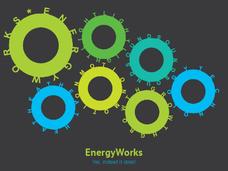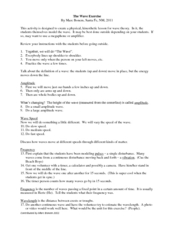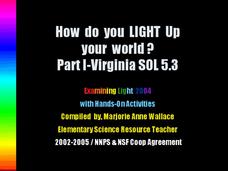Magic of Physics
Wave Machine
Three main factors determine the wave height experienced in the ocean. Scholars use a virtual simulator to alter wind speed, fetch, and duration. Each combination creates a unique wave measured in significant height.
Virginia Department of Education
States and Forms of Energy
Energy is just energy, right? Explain various forms of energy to your young scientists by using an interactive experiment that contains common objects to demonstrate complex concepts. Pupils conduct experiments for radiant, thermal,...
National Energy Education Development Project
Energy Works: Yes, Indeed it Does!
Moving from its definition to how it moves and its different types, scholars see different examples and then move into its application and use in everyday lives, in an energy-based presentation.
American Chemical Society
The Periodic Table and Energy-Level Models
Teach your class to think of electrons as tiny packets of energy that travel in waves. Through a short video and diagram, participants see how electrons are located around the nucleus of an atom. They then get into groups and try to...
K5 Learning
Why Does the Ocean have Waves?
Six short answer questions challenge scholars to show what they know after reading an informational text that examines waves—what they are, what causes them, and how different Earth factors affect their size and strength.
Curated OER
Energy and Energy Conversion
Third graders investigate different energy conversions through hands-on activities. In this energy lesson, 3rd graders move through four stations and conduct experiments illustrating energy conversions. Wave energy, chemical energy,...
CK-12 Foundation
Stadium Wave
If you are at a sports match and the crowd starts two waves that are both headed toward you at the same time, what do you do? The simulation applies the concepts of constructive interference and destructive interference to that very...
Curated OER
The Sun's Energy
Sixth graders examine how the sun's energy arrives as light with a range of wavelengths. They discuss the characteristics of light, examine the color of light using a spectroscope, and conduct an experiment using water and thermometers....
Curated OER
Waves: the Nature of Waves
Each of the slides has some information or a few definitions about the travel of energy through different media. There are references given to obtain further information, which makes this slideshow a great tool for introduction or as a...
PBS
Longitudinal Waves | UNC-TV Science
Discover whether sound travels in space and other fascinating science facts. Scientists explore energy transfer by longitudinal waves and learn about compression, rarefaction, amplitude, and wavelength while watching an animated video....
US Department of Energy
Sunlight and Evaporation
Here is a simple inquiry experiment designed to demonstrate that the energy from sunlight can evaporate water. Young scientists follow provided procedural steps to construct a model of our atmosphere using a bowl, a cup, water and...
Mr. E. Science
Characteristics of Waves
Waves, waves, and more waves. Here, class members look at the many types and characteristics of energy waves including transverse, longitudinal, standing, seismic, p-waves, s-waves, and l-waves.
Columbus City Schools
Making Waves
Learning about waves can have its ups and downs, but a demo-packed tool kit has the class "standing" for more! Learners gain experience with several different wave types, organizing observations and data, and wave terminology. The...
National Energy Education Development Project
The Science of Energy
Did you know the word energy comes from energeia, a Greek word? Introduce learners to the four types of potential energy, five types of kinetic energy, and energy transformation with a presentation about where we get our energy and how...
Cornell University
Light Waves: Grades 6-8
Explore the behavior of light with different materials. Collaborative groups determine whether certain materials absorb, reflect, diffract, or transmit light waves. They then measure the angle of incidence and angle of reflection.
Chymist
Make a Low Energy Radio Transmitter
How do you demonstrate radio transmissions? Pupils build a low-energy radio transmitter by constructing two coils from magnet wire and connecting them to audio/phone plugs. The resource provides the details on how to build the...
The Science Spot
The Wave Exercise
During a instructional activity on wave motion, physical science participants basically act out the waves as a group. Through their movements, the amplitude, speed, frequency, and wavelength are all identified. Ideas for modeling the...
Curated OER
How Do You Light Up Your World?
A fabulous presentation on light is here for you. In it, learners view slides which cover many important concepts of light. They understand exactly what light is, what the main sources of light are, what opaque, transparent, and...
Scholastic
Study Jams! Sound
Listen in as Mia and Sam expound on sound. It is caused by vibrations and travels in waves. It has the qualities of pitch, frequency, and volume. This hip animation displays a graph to depict the frequency and amplitude of sound waves....
Curated OER
Energy Motion in the Ocean
Learners explore the wave energy that is generated and transferred in the ocean. Through the use video and the Internet, students explore the aspects of a wave and how its energy affects the ecology of the seashore.
Curated OER
The Phenomenon of Sound: Waves
Students explore sound waves. In this sound waves lesson, students brainstorm different sounds and how sounds move or travel. Students then create a KWL chart and work through six different lab activities to examine how sound waves...
Curated OER
Seeing and Feeling Sound Vibrations
Groups rotate through a series of stations and work with a partner to observe sound waves. Children describe sound in terms of pitch, volume, and frequency. To apply their new knowledge, the class considers how these observations can...
Curated OER
An Air-Powered Car
Youngsters read text about an environmentally-friendly car. They try to figure out the meaning of the vocabulary in the text and discuss issues related to alternative energy sources. This thoughtful, well-designed plan has all the...
Curated OER
Wave Properties
Students identify how waves transfer energy without transferring matter. They contrast transverse and compressional waves and relate wave speed, wavelength, amplitude and frequency. Lesson includes PowerPoint presentation.
Other popular searches
- Energy Waves
- Energy Waves Physics
- Electromagnetic Energy Waves
- Ocean Waves Energy
- Radiant Energy Waves
- Energy Waves Powerpoint
- Mechanical Waves and Energy
- Waves and Energy Waves
- Light Energy Waves
- Energy of Waves
- Energy and Waves
- Energy Moving as Waves

























